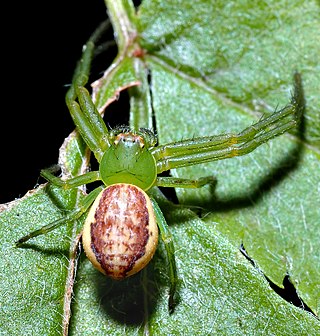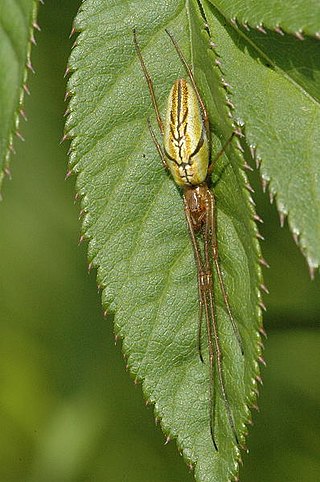
Theridiidae, also known as the tangle-web spiders, cobweb spiders and comb-footed spiders, is a large family of araneomorph spiders first described by Carl Jakob Sundevall in 1833. This diverse, globally distributed family includes over 3,000 species in 124 genera, and is the most common arthropod found in human dwellings throughout the world.

The spider genus Steatoda, in the family Theridiidae, includes about 120 recognized species, distributed around the world. One common name is cupboard spider, for many species build their webs in dark, sheltered, undisturbed places around the house or garden, in sheds and garages, under garden, compost bins, and the like. Signs of the cupboard spider include small white spots of spider droppings, like small splashes of paint, on the floor underneath the web.

Phlegra is a genus of jumping spiders that was first described by Eugène Louis Simon in 1876. The name is a reference to a mythical location in both Greek and Roman mythology.

Salticus is a genus of the family Salticidae. Salticus is the type genus for the family Salticidae.

Cheiracanthium, commonly called yellow sac spiders, is a genus of araneomorph spiders in the family Cheiracanthiidae, and was first described by Carl Ludwig Koch in 1839. They are usually pale in colour, and have an abdomen that can range from yellow to beige. Both sexes range in size from 5 to 10 millimetres. They are unique among common house spiders because their tarsi do not point either outward, like members of Tegenaria, or inward, like members of Araneus), making them easier to identify.

Alopecosa is a spider genus in the family Lycosidae, with about 160 species. They have a largely Eurasian distribution, although some species are found in North Africa and North America.

Diaea is a genus of crab spiders first described by Tamerlan Thorell in 1869. Most species are found in specific locations except for D. livens, which occurs in the United States and D. dorsata, which has a palearctic distribution. Adults are 5 millimetres (0.20 in) to 7 millimetres (0.28 in) and tend to hide in and around vegetation, especially flowers, where their color allows them to blend in to their surroundings.
Ozyptila is a genus of crab spiders that was first described by Eugène Louis Simon in 1864. It has been misspelled as "Oxyptila" in multiple accounts.

Clubiona is a genus of sac spiders that was first described by Pierre André Latreille in 1804.

Tetragnatha is a genus of long-jawed orb-weavers found all over the world. It was first described by Pierre André Latreille in 1804, and it contains hundreds of species. Most occur in the tropics and subtropics, and many can run over water. They are commonly called stretch spiders in reference to their elongated body form and their ability to hide on blades of grass or similar elongated substrates by stretching their front legs forward and the others behind them. The name Tetragnatha is derived from Greek, tetra- a numerical prefix referring to four and gnatha meaning "jaw". Evolution to cursorial behavior occurred long ago in a few different species, the most studied being those found on the Hawaiian islands. One of the biggest and most common species is T. extensa, which has a holarctic distribution. It can be found near lakes, river banks or swamps. Large numbers of individuals can often be found in reeds, tall grass, and around minor trees and shrubs.

Euryopis is a genus of comb-footed spiders that was first described by Anton Menge in 1868.










